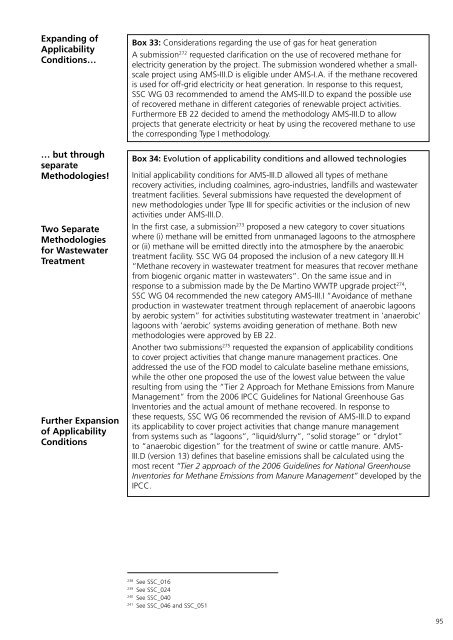Understanding CDM Methodologies - SuSanA
Understanding CDM Methodologies - SuSanA
Understanding CDM Methodologies - SuSanA
Create successful ePaper yourself
Turn your PDF publications into a flip-book with our unique Google optimized e-Paper software.
Expanding of<br />
Applicability<br />
Conditions…<br />
… but through<br />
separate<br />
<strong>Methodologies</strong>!<br />
Two Separate<br />
<strong>Methodologies</strong><br />
for Wastewater<br />
Treatment<br />
Further Expansion<br />
of Applicability<br />
Conditions<br />
Box 33: Considerations regarding the use of gas for heat generation<br />
A submission 272 requested clarification on the use of recovered methane for<br />
electricity generation by the project. The submission wondered whether a smallscale<br />
project using AMS-III.D is eligible under AMS-I.A. if the methane recovered<br />
is used for off-grid electricity or heat generation. In response to this request,<br />
SSC WG 03 recommended to amend the AMS-III.D to expand the possible use<br />
of recovered methane in different categories of renewable project activities.<br />
Furthermore EB 22 decided to amend the methodology AMS-III.D to allow<br />
projects that generate electricity or heat by using the recovered methane to use<br />
the corresponding Type I methodology.<br />
Box 34: Evolution of applicability conditions and allowed technologies<br />
Initial applicability conditions for AMS-III.D allowed all types of methane<br />
recovery activities, including coalmines, agro-industries, landfills and wastewater<br />
treatment facilities. Several submissions have requested the development of<br />
new methodologies under Type III for specific activities or the inclusion of new<br />
activities under AMS-III.D.<br />
In the first case, a submission 273 proposed a new category to cover situations<br />
where (i) methane will be emitted from unmanaged lagoons to the atmosphere<br />
or (ii) methane will be emitted directly into the atmosphere by the anaerobic<br />
treatment facility. SSC WG 04 proposed the inclusion of a new category III.H<br />
“Methane recovery in wastewater treatment for measures that recover methane<br />
from biogenic organic matter in wastewaters”. On the same issue and in<br />
response to a submission made by the De Martino WWTP upgrade project 274 ,<br />
SSC WG 04 recommended the new category AMS-III.I “Avoidance of methane<br />
production in wastewater treatment through replacement of anaerobic lagoons<br />
by aerobic system” for activities substituting wastewater treatment in ‘anaerobic’<br />
lagoons with ‘aerobic’ systems avoiding generation of methane. Both new<br />
methodologies were approved by EB 22.<br />
Another two submissions 275 requested the expansion of applicability conditions<br />
to cover project activities that change manure management practices. One<br />
addressed the use of the FOD model to calculate baseline methane emissions,<br />
while the other one proposed the use of the lowest value between the value<br />
resulting from using the “Tier 2 Approach for Methane Emissions from Manure<br />
Management” from the 2006 IPCC Guidelines for National Greenhouse Gas<br />
Inventories and the actual amount of methane recovered. In response to<br />
these requests, SSC WG 06 recommended the revision of AMS-III.D to expand<br />
its applicability to cover project activities that change manure management<br />
from systems such as “lagoons”, “liquid/slurry”, “solid storage” or “drylot”<br />
to “anaerobic digestion” for the treatment of swine or cattle manure. AMS-<br />
III.D (version 13) defines that baseline emissions shall be calculated using the<br />
most recent “Tier 2 approach of the 2006 Guidelines for National Greenhouse<br />
Inventories for Methane Emissions from Manure Management” developed by the<br />
IPCC.<br />
239240241<br />
238<br />
See SSC_016<br />
239<br />
See SSC_024<br />
240<br />
See SSC_040<br />
241<br />
See SSC_046 and SSC_051<br />
95

















